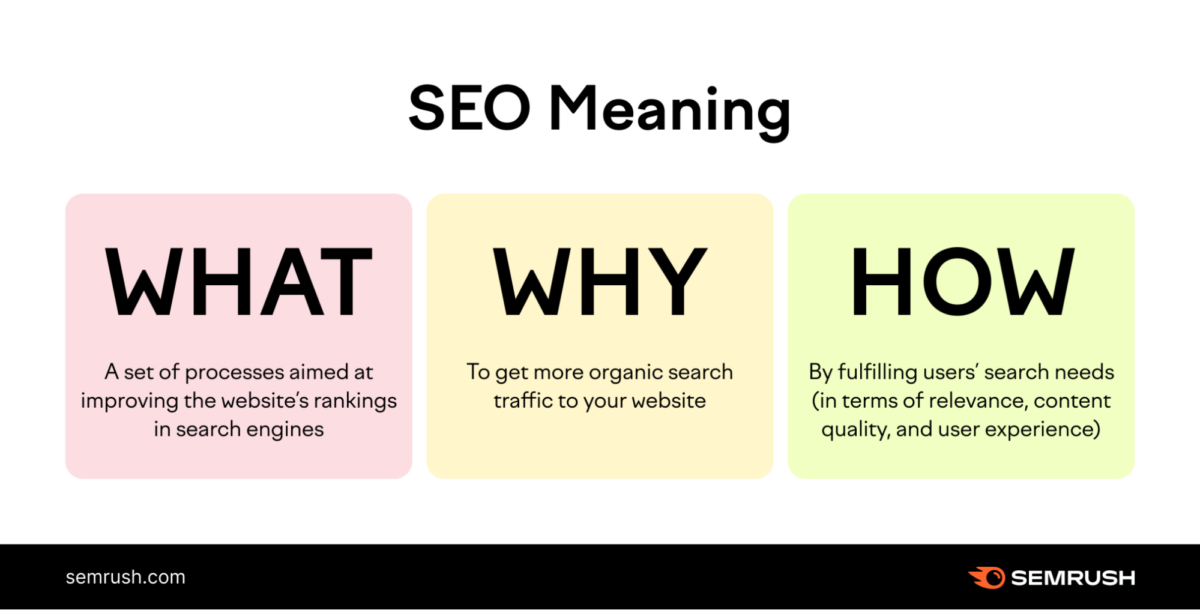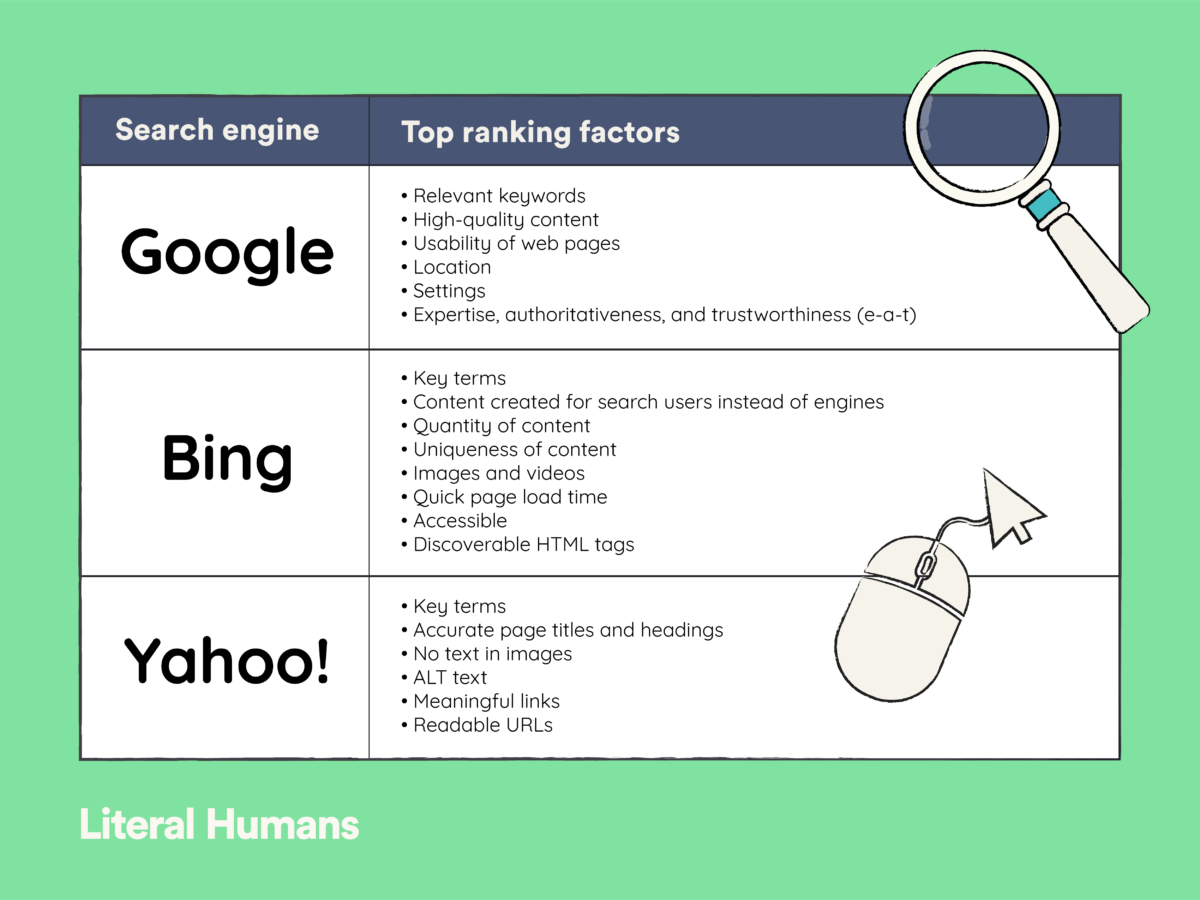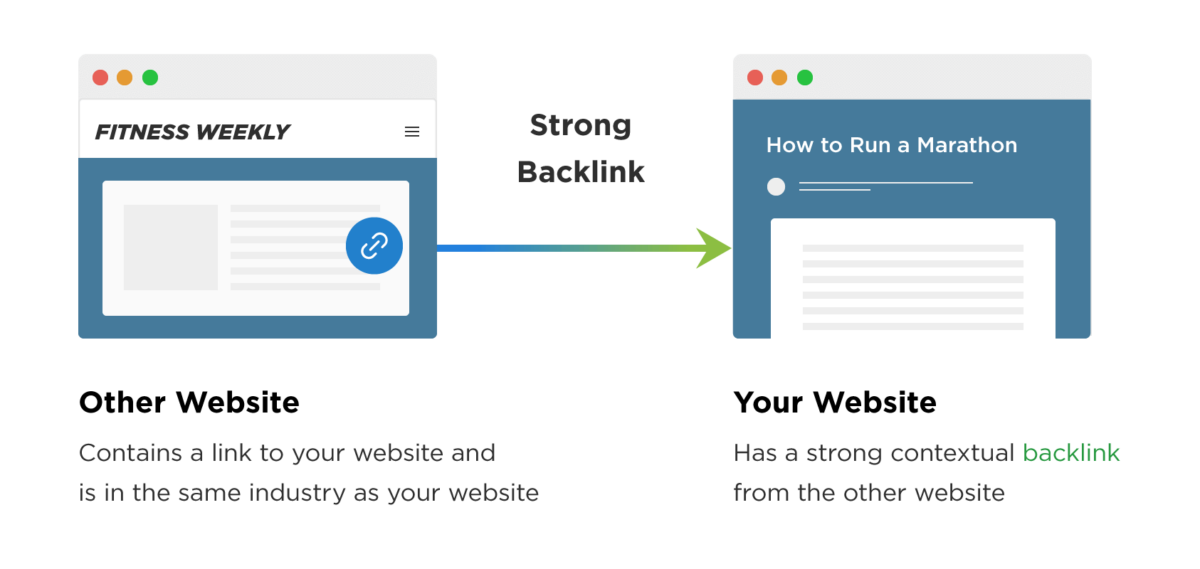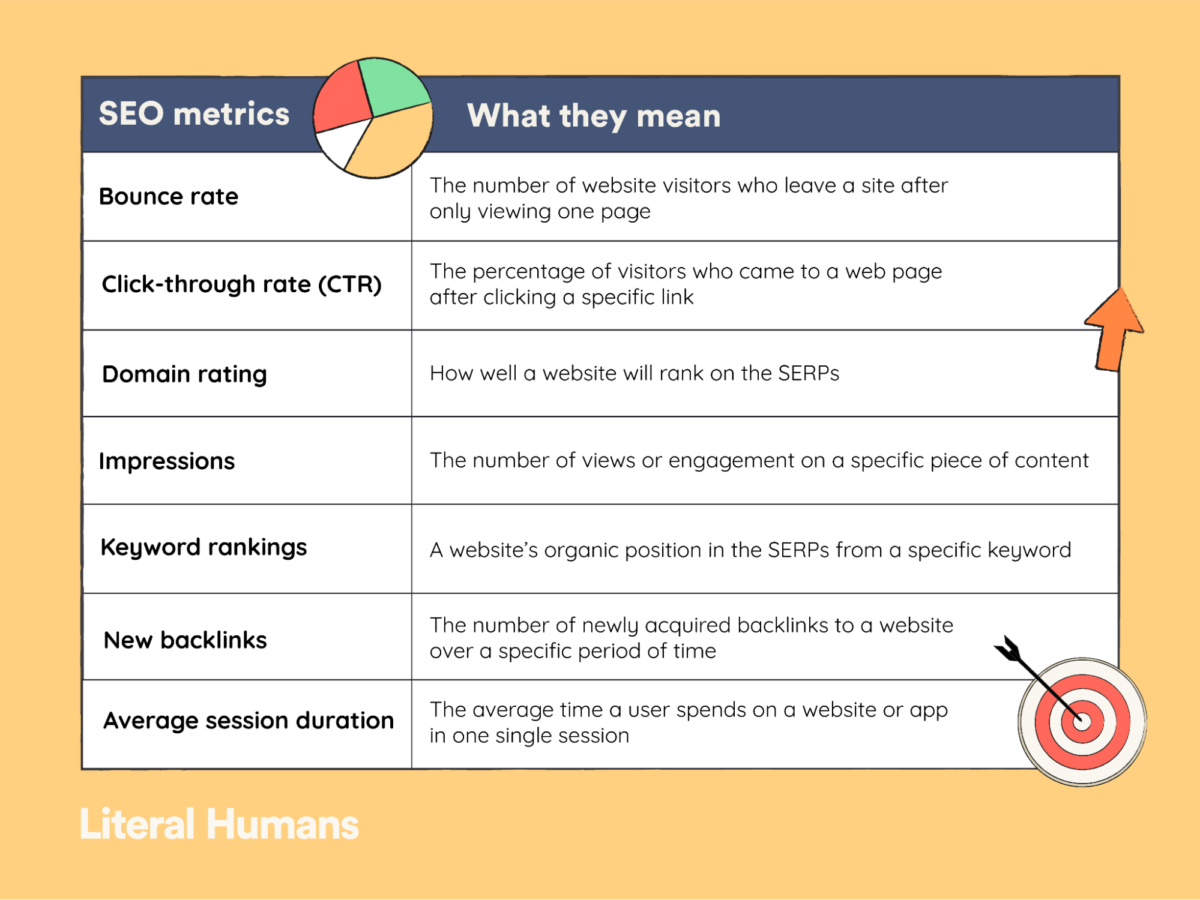The internet has grown so big it feels infinite with no signs of slowing down either. It’s even estimated that if you wanted to download the whole thing, it would take approximately 11 trillion years. No one has time for that.
This is why we rely on search engines to sift through information. They make it easier for users to find what they need but also present business owners with an opportunity. When you know how to rank on the search engine results pages (SERPs), your brand gets seen.
But let’s not get too ahead of ourselves. Before you begin reaping the rewards of SEO, you have to be clued up. So, let’s explore what this tactic is, why you need to optimize it, and how you can use it as a stepping stone to success.
What is SEO?
SEO stands for search engine optimization, which is the process of increasing the quality and quantity of traffic to your website. Doing this helps the site rank higher on search engines like Google, Yahoo!, and Bing, where your audience will begin their buyer journey.

SEO works in four ways. The one you focus on will depend on what you want to achieve, but it’s best to use all of them. Take a look at them below.
- On-page SEO: This is when you optimize web pages to bring in organic traffic. Examples include content marketing, keyword research, and meta descriptions.
- Off-page SEO: The next method concerns any activity outside your website to gain traffic. For example, social media, link building, and guest posting.
- Technical SEO: The aim here is to improve the user-friendliness of your website’s technical elements of your website. Thinking about structure, speed, and mobile optimization helps search engines navigate your pages properly.
- Local SEO: Some people will search for businesses close to them. This is why some search engines include location as a ranking factor. Local SEO is how you gain visibility in local search results.
How do search engines work?
Any marketer’s first step to SEO is figuring out how a search engine actually works. This is because everything, including your website, chosen keywords, and content, needs to align with their requirements. If they don’t, your strategy will be totally ineffective.
While most search engines operate slightly differently, the basic principle is the same. So, let’s break it down. They use programs called spiders, crawlers, or bots to make web pages findable. Then, all a user has to do is type in a search query, and they’ll get a list of results that prioritize the most relevant sites.
Behind the scenes, the process happens in three stages, which look like:
- Crawling: New pages appear on the internet constantly, and others will update their content continuously. Search engines need to be aware of these changes, so they will use web crawlers to keep up to date.
- Indexing: Indexing is where the search engines analyze the information they’ve found. The content is put into a database to be read and understood.
- Ranking: Not all websites are made equal. Search engines make sure we get the best. They rank sites based on numerous factors to determine where they will feature on the search engine results pages (SERPs).
How do users choose a search engine?
Users choose their search engines based on many reasons. Some like the convenience of their device’s default, while others consider things like privacy and the volume of ads. A few are drawn in by shared values. Ecosia, for instance, plants a tree after every search.

Why does this matter? Not knowing which search engine your target audience is using could impact the success of your strategies. Content optimized for Bing’s ranking factors won’t be very useful if your consumers look to Google for solutions.
Considering that 92% of all global search volume comes from Google, this is most likely the case, but you shouldn’t assume. It’s a much better idea to learn their preferences and meet them wherever they are. You can get this information in various ways, including by:
- Sending out surveys
- Using analytics tools
- Creating buyer personas
- Conducting demographic research
Why do you need SEO?
If you’re familiar with SEO, you’ll know a strategy takes time, patience, and plenty of effort to execute. It could be even longer before you start seeing results. For these reasons, you may wonder if it’s worth the hassle, but the short answer is: yes, it is.
Alongside many other benefits, SEO gets your content and whatever it’s promoting seen by your target audience. By capturing your potential customers when they need you most while searching for a solution to a problem, they become more likely to purchase.

But to really prove our point, here are some other reasons to get started.
- User experience: SEO makes you think about the functionality of your website. Working links, an easy-to-navigate site, and an attractive first page will enhance your user’s experience and keep them around for longer.
- Credibility: Readers know a reputable search engine won’t show poor-quality websites on its homepage. So, when your link appears at the top, it automatically becomes associated with trustworthiness.
- Brand awareness: It might go without saying, but increased visibility leads to familiarity. 52% of consumers think recognizing a brand name is the most important factor leading to a purchase.
- Cost-effectiveness: Unlike other digital marketing strategies, SEO doesn’t depend on paid advertising. When you put the effort in, it can be a highly effective tactic, even for those with tight budgets.
- Competitive advantage: SEO tactics make it easy to find where your competition is falling short and which gaps are available to fill. This means you can overtake them in the race to the top of the SERPs and always stay one step ahead.
As a site owner, you need to understand the importance of ranking higher than your competition. But it’s not an easy task by any means. That’s why there are so many SEO techniques for you to consider. Let’s explore the options so you can find the right ones.
SEO best practices
There’s a lot to learn about SEO, especially for beginners. But don’t worry, we’ve got just the thing to calm those nerves. Below is a guide to the practices that build a powerful SEO strategy. With a combination of them all, you’ll put your best foot forward and become an expert before you know it.
1. Know the ranking factors
By now, you know that search engines use ranking factors to sort the results they display. But to develop a successful SEO strategy, you need to know what’s actually expected of your content and website. So, let’s uncover what influences your position on the SERPs.
As we mentioned earlier, each search engine will have different preferences. For this reason, we will explore the top three choices by popularity, which were named Google, Bing, and Yahoo! by HubSpot. We don’t understand every decision the algorithms make, and there are ranking factors that remain puzzling. However, you can find pages of guidelines on the search engines’ websites that describe exactly what you need to do.
Here is a rundown of the most important criteria you need to be aware of.

This list is accurate today, but next year, everything could be different. For example, Search Engine Journal discovered that Google makes “thousands of changes each year.”
Its highly complex algorithm, known as PageRank, doesn’t stay the same for long. There’s only one way to master it, through link building. Don’t fret if you don’t know what this means because it happens to be our next step for building a winning strategy.
2. Understand the power of link-building
We’re sure you’re familiar with hyperlinks. You’ve probably clicked on plenty of them when buying something or surfing the web.
And if you’ve got a content marketing strategy, then you’ve likely done internal link-building. This is when a link on your website leads to another resource on-site, which is hugely valuable in SEO because it helps search engines understand every single page.
However, we will focus on external links, which is when a link directs from one website to another. When your page receives these, a signal is sent to algorithms that your page is high quality because it’s been cited.

Google explains, “In general, webmasters can improve the rank of their sites by increasing the number of high-quality sites that link to their pages.”
So, not only do websites have to link to your content, but they also have to be reputable enough before you can improve your search engine rankings. It’ll take time before these start rolling in, but here are ways to speed up the process:
- Social media marketing: Social channels offer a space to share thoughts and discuss industry topics. When you showcase your content and get it in front of people with blogs and sites, they might link to it because they remember the interactions you’ve had.
- Guest posting: When you create content for someone else’s website, use your own as a point of reference and link back to it. Make sure it adds value and is relevant, though, or your post probably won’t get published. Find our guide here.
- Broken link building: This tactic lets you take advantage of those frustrating links that lead nowhere. Reach out to the site owner, who will be grateful for the heads-up, and suggest a link of your own.
- Attend in-person events: Seeing other industry leaders face-to-face makes you much more memorable. Use these opportunities to network and build relationships with people who share your interests and niches.
3. Conduct keyword research
Imagine your consumer is planning a date and needs to find the perfect restaurant. Even if they don’t know what they want to eat yet, they will narrow down the Google search by typing phrases like “romantic dining” or “restaurants with a view.”
Search terms like these are the real and specific phrases your target audience uses. They’re a crucial part of your strategy because knowing how people discover products similar to yours means you can adjust your content strategy and ads accordingly.
We’d agree that the business below nailed it.

Since that idea is taken, you need to leverage the keywords in your marketing materials, scattering them through content in a way that feels organic. This will boost your rankings because the search engines identify your website as a perfect match for the query.
Getting this right is crucial. So, how do you find the best keywords? One way is by simply conducting a search of your own. Start with a phrase you think will be popular, and look at what else the engine suggests. Jot these down until you have a long list of topic ideas.
A Google search shouldn’t be the extent of your brainstorming session. Various other methods will give more data-driven, detailed results, including:
- Analyze competitor’s keywords
- Try social listening to hear what online conversations are being had
- Use Google Search Console to find your most important search queries
- Subscribe to keyword research tools
4. Produce high-quality content
Both link building and keyword research will lose all effect if you haven’t invested in high-quality content. This powerful tactic helps you strike the perfect balance between being rank-focused and audience-centric.
With carefully planned SEO efforts, you can get many more eyes on your content. But what good is that if they don’t like what they see? Delivering something that’s engaging, useful, and relevant will keep consumers on your website and bring them back again.
But the benefits don’t stop there. The quality of your materials also directly impacts how search engine algorithms determine their SEO value. So, you must create something worth noticing if you want to reach the top of the SERPs.

Publishing content that meets all of these demands can be tricky, so here are some tips to help you ace it:
- Diversify the types of content you publish: When you get creative, consumers stay interested. It also helps your content stand out against the changing search engine algorithms. Experiment with blogs, infographics, podcasts, and videos.
- Always do ALT text: ALT text describes the function of an image you’ve placed on your site. It helps search engines fully understand a page, which gives your content more value. It also improves accessibility for those who need it, so win-win!
- Don’t forget to update: New content is always exciting to publish, but it’s just as important to keep existing materials accurate and up-to-date for credibility.
- Keep usability in mind: Regardless of the format you post in, make sure it’s compatible with mobile devices, loads quickly, and has an easy-to-read structure.
- Be original: Copying and pasting from another source tells the world you haven’t got anything new to say. Instead, think about what’s missing from the content to create it yourself, give your own take on an existing discussion, or add personality.
- Optimize your title tag: Search engines look closely at your title tag, so use it to show them what your content is about. Don’t forget to put your keywords in here.
5. Utilize SEO tools
Not every business is blessed with a dedicated SEO specialist, a big team, or lots of money for investments. Without these, you might think that a strategy of your own won’t cut it.
This is not the case. Whatever position your company might be in, you still have the same opportunities as the big players. All you need to do is put SEO tools to good use.
These easy-to-use platforms are readily available to help you work smarter and faster. Some of them are completely free too. And no, you’re not dreaming.
Before capitalizing on these services, research which ones would be the right fit for your company. It’s not a good idea to subscribe to the first one. Use your needs, budget, and expectations as deciding factors when choosing, as this brings the best results.
The list below is far from exhaustive, but it’ll give you a good idea of what’s out there.
- Google Analytics: This service tracks mobile app and website traffic, which it reports back to you. It’ll show you if your SEO strategy is having a positive effect.
- Bing Webmaster Tools: Take advantage of resources designed by Bing to help you perform better on its search engine, such as a site audit and keyword research tool.
- Semrush: Has many helpful tools all on one platform, including an on-page SEO checker, a position tracker, a keyword manager, and a backlink gap finder.
- Ahrefs Webmaster Tool: Uncover insights such as what your website is ranking for on Google, who is linking to your page, and how to fix any problems you have.
- AlsoAsked: This tool will give you a deeper understanding of consumer searches by offering live data and intent clustering from Google, saving you research time.
6. Make your website user-friendly
You can’t lure customers in with false promises and dressed-up page titles. Even though the goal is to improve visibility, retention is as important as acquisition for SEO success.
At this point in the article, you’ll understand the importance of good, relevant content. But have you considered the platform it’s being displayed on?

The majority of consumers’ first impressions relate to your business’s web design. The same goes for search engines because they value user experience highly amongst other ranking factors. So, the next step is ensuring your site is functional and aesthetic.
You can enhance user-friendliness in many ways. Which techniques you opt for will depend on your target audience, brand identity, and content. However, below are the non-negotiables if you want to do your SEO strategy justice.
- Accessibility features
- Fast page loading
- Mobile-friendliness
- Clear layout with a visual hierarchy
- Clever use of white space
- Obvious navigation buttons
- Motivating searchers with call-to-actions
Once you’ve revamped your website for the user experience, you can see how well it works by conducting an A/B test. In this experiment, you’ll give your audience different versions of a webpage to see which version performs the best.
7. Combine SEO with SEM
Search engine marketing, or SEM, is an approach with the same objectives as SEO. That being said, it is a completely separate strategy. You might think you have to choose one or the other, but actually, they complement each other when combined.
With SEM, you would pay search engines to list your website at the top of its SERPs when a user types in a particular keyword.
Typically this will be done through Google Ads, an online advertising platform where marketers bid to display their content, such as product listings or service details.
This platform is popular because it uses pay-per-click (PPC). Companies pay only when a consumer clicks on a link, guaranteeing that no money will be wasted. And if that wasn’t enough, paid ads have an average ROI of 200%, so you’ll make money instead.

This blend of strategies boasts so many advantages. The SEO side of things promotes sustainable long-term growth that potential customers can trust. SEM enables that development by providing immediate results and increased sales.
Together, they’ll help you increase your site’s visibility by expanding your audience, maximizing your reach, and opening up new opportunities.
8. Measure your results with metrics
Let’s say you’ve spent months working on the perfect SEO strategy. You’ve launched it, waited, and now you think you’ve seen results. But how can you be sure?
The truth is, if you don’t measure the performance of your strategies, your efforts will be wasted. This is why you need to track your progress with metrics. These measurements will show you what needs to be improved, what’s working well, and when an update is necessary. You’ll never miss a frustrating algorithm change again.
The best practice is monitoring various metrics to paint a fuller picture of how your SEO strategy is performing. If you’re looking for a good starting point, try this list below.

Don’t forget to keep coming back to these periodically and introduce new metrics as your business develops. We’d recommend scheduling this check-in monthly or even weekly.
Ready to begin your SEO journey?
Hopefully, you’ll now be as sure as we are that SEO works wonders. But you mustn’t get too carried away with it. Bending the search engine’s rules with keyword stuffing, spamming, and sneaky redirects could cost you your place on the SERPs.
Ethical SEO might be more of a slow-burning process, but it makes your ranking position safe. Use the practices above to serve the user’s intent and play the game the right way. Your business will soon be awarded the attention it deserves.










